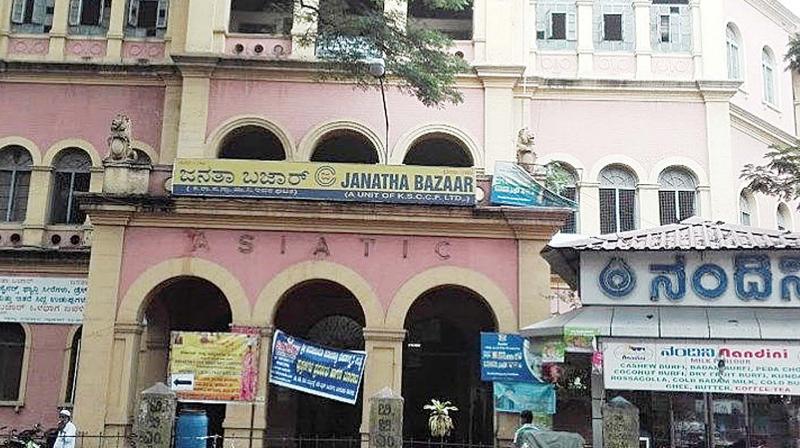Demolishing Janatha Bazaar? High Court asks government
Much of this history came to light in 2018, when news of the demolition was revealed.

Bengaluru: It is fitting, perhaps, that the preliminary hearing against the planned demolition of Janatha Bazaar on Kempegowda Road took place at the High Court on Monday, September 10. It was on September 11, 1935 the Asiatic Company, opened its doors to the public. Arched openings, teak wood doors, cast iron spiral staircases, parapets and chequered flooring: Janatha Bazaar is a snapshot of architecture from the early 20th century. One of the earliest multi-storey commercial buildings in the city, it is also the only structure attributed to the architectural contributions of the renowned horticulturist and townplanner G.H. Krumbiegel, who designed it during his tenure as consulting architect to the state of Mysore.
Today, in the eyes of our political class, however, it represents potential. The potential for a 14-floor commercial complex, with underground parking. Much of this history came to light in 2018, when news of the demolition was revealed. “We started working on our petition in April. It took us a while to put the history of the building together,” says Meera Iyer, convenor, INTACH, referring to the Asiatic Company's rather chequered past. The court, which heard the PIL requesting that no precipitating action be taken on Janatha Bazaar, has asked the government to take instructions about whether or not the building has been slated for demolition, said a source familiar with the matter.
REVISED MASTER PLAN 2031
The draft of the Revised Master Plan 2031 includes a section on heritage. Here, Janatha Bazaar has been listed as a Heritage Building under the Karnataka Town and Country Planning Act. Although assurances were made in April that no move would be made until the election, the petitioners now fear that the government might take a clandestine approach to the demolition of the building, which could happen at any time without prior notice. A stay order, however, was imposed on the RMP 2031, after several citizen-led activist groups and organisations objected to the BDA’s involvement. “We filed a PIL with the court and the stay (on RMP 2031) is still on,” said Sridhar Pabbisetty, of the Namma Bengaluru Foundation.
CONTROVERSY
The proposal for demolition was put together, swathed in secrecy, early in 2018. When H.C. Kumaraswamy, grandson of one of the Chief Engineers who worked on the building, visited it in April this year, he found, to his dismay, that the tell-tale corrugated-iron sheets had sprung up around it. A plaque justified the government's stand, which was that the government was structurally weak and not fit for occupation. The Karnataka State Cooperative Consumers Federation, which ran the Jantha Bazaar until 2014, when the five-year-renewal on the 50-year-lease ran out, refuted the claim, saying the building was quite strong but had been neglected by the Public Works Department. The Public Works Department was quick to deny the proposal for Janatha Bazaar, which includes a new shopping complex with an underground parking lot. When the news broke, however, members of INTACH swung into action and filed a PIL seeking to stop the demolition. "This is just the first step for us," says Ms Meera Iyer. "The Asiatic Company is also the only building in the city, outside Lalbagh, that has been attributed to G.H. Krumbiegel." When they received a panic call from Mr H.C. Kumaraswamy, a team of representatives met with Chief Secretary Ratna Prabha. "The Namma Bengaluru Foundation also filed an RTI as we put the case together."
HISTORY
On September 11, 1935, the Asiatic Company threw open its doors to the public. It was an insurance business set up by one Gopala Rao, an ex-cashier with Mysore Bank. The inauguration was a grand affair, with His Higness Srii Kantirava Narasimharaja Wadiyar in attendance. “I anticipate the day when compulsory insurance of motor vehicles against third party risks will be enforced by law,” was the monarch's far-sighted observation as he made his inaugural speech. The Asiatic Company represented, at the time, the Mysore kingdom's renewed emphasis on commerce. Today, it is one of the few pre-Independence buildings that has endured, and demolishing it would affect the legacy of our city, states the petition filed by INTACH, of which a copy is with Deccan Chronicle. "Asiatic Building weaves together several strands of history, marrying the impetus provided to business by the former Mysore kingdom," it says. The Asiatic Building then went on to serve as the location of the Store Purchases Committee of the government of Karnataka. In 1964, the Karnataka State Cooperative Consumers’ Federation was established, as a consumer's response to high prices. They founded the “Janatha Bazaars”, a string of complexes across the state. The Asiatic Company building went on to house the first Janatha Bazaar, which was set up in 1966. The Employment Exchange, BSNL and the Mysore Silk Corporation all set up their offices there. In 2008, the lease came to an end and a year later, according to INTACH's petition, a high-powered committee came into force to set up a new agreement. This was to last five years, from 2009 to 2014 after which it come up for renewal. In 2014, however, occupants of the Asiatic Building found eviction notices at their doorsteps. In October 2016, the proposal for a commercial complex was floated for the first time, followed by the Draft of the Revised Master Plan in 2017, which went on to declare the Asiatic Company a heritage structure.

